What Are Link Insertions And Niche Edits: Link Building On Easy Mode
Daniel Trick
Dec 08, 2023
8 min read
Link insertions sound easy.
You find a quality, relevant piece of content on a third-party website and ask the site owner to add a link to your site.
The site owner can enhance their article with an additional resource, and you get a shiny new backlink.
It’s a win-win.
But it’s not that simple.
You need to find the right websites, handle the outreach, and keep your link profile natural-looking.
In this guide, we’ll walk you through the process our fatjoe link building experts use to get high-quality link inserts via our niche edit service.
We’ll cover:
- What link insertions are
- The benefits of link inserts
- How to do link insertions step-by-step
What Are Link Insertions?
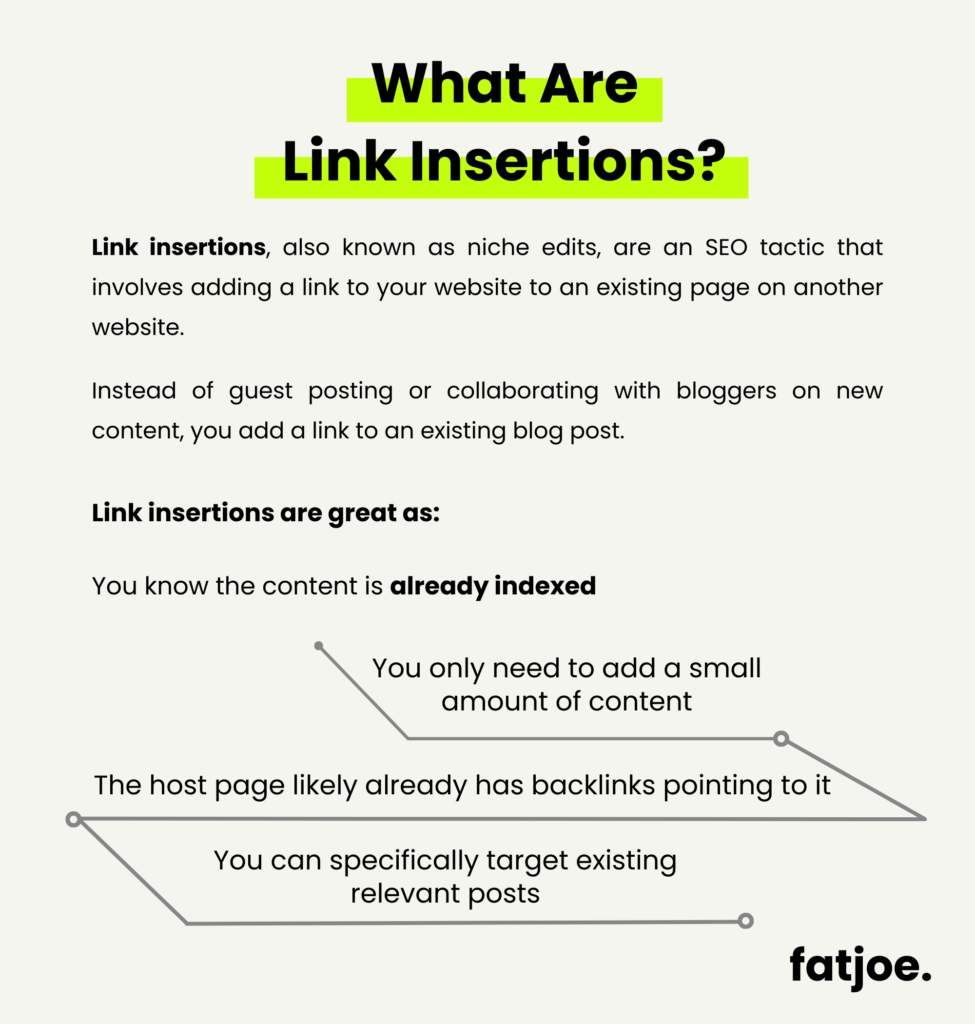
Link insertions, also known as niche edits, are an SEO tactic that involves adding a link to your website to an existing page on another website. Instead of guest posting or collaborating with bloggers on new content, you add a link to an existing blog post.
This offers two significant benefits:
- The page has already been indexed by search engines.
- The page may have backlinks pointing to it.
The result is that your link can pass on more link equity and start helping your website faster.
Link Insertions vs. Guest Posts
Link insertions and guest posts are two of the most common link building strategies. However, they’re executed in different ways.
With link insertions, you add a link to an existing page on a third-party website.
This means there’s no need to create new content. You simply add a link to a page that has already been published.
Guest posting involves a bit more work.
You write new content specifically for another website. In the article and author bio, you can include external links to your site.
Both methods can help you earn more backlinks.
Link Insertions vs. Niche Edits
Link inserts and niche edits are one and the same! Niche Edits is simply another term given to the process of link insertions, though it does typically refer specifically to editing existing blog posts – like we do with our niche edit service.
Benefits of Link Insertions for SEO
Link insertions can be really helpful for SEO. Here’s why:
Improved Domain Authority
Domain Authority (DA) is a score used by SEO tools to measure the strength of a website’s backlink profile and its ability to rank high in search engine results. It’s also known as Domain Rating (DR).
While DA is not a ranking factor, it’s still a useful metric.
A Backlinko study found that DR correlates with higher rankings:
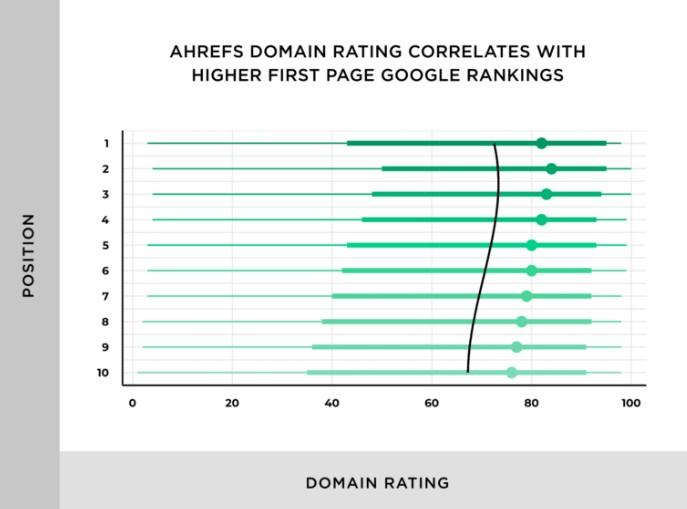
Getting high-quality link insertions can help increase your DA/DR score. The same things you’re doing that lead to an improvement in DA/DR metrics can also lead to higher rankings and more organic traffic.
Improved Visibility and Ranking
Backlinks are one of the most important Google ranking factors.
When your website has a lot of good links from other websites, search engines view your site as more authoritative. This can make your website appear higher on search engine results pages (SERPs).
In a recent survey, SEOs ranked the effectiveness of link building on a scale of 1 to 10. The average score was 7.8 out of 10.
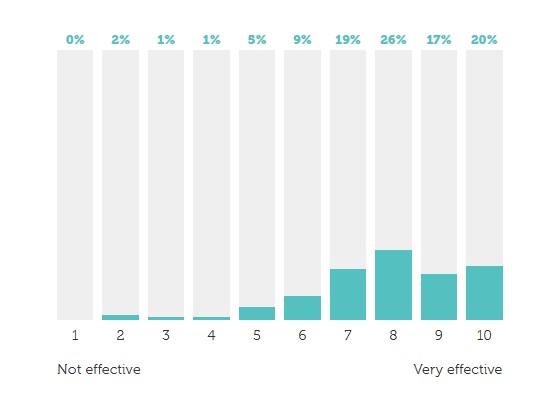
Link inserts are one of the most effective link building tactics.
While guest posts need time to be crawled and indexed, the SEO benefits of link insertions are much faster.
More Natural-Looking Link Profile
Link insertions can contribute to a more natural link profile.
A sudden influx of guest post links can look unnatural to search engines if not done correctly.
Adding contextual link inserts can make your link profile less likely to appear manipulated or forced.
It wouldn’t be natural for all your links to come from new URLs.
It wouldn’t be natural for all your links to come from existing URLs.
Having a mix of guest posts and niche edits is the most sustainable link building strategy. pic.twitter.com/edT8GshgtQ
— Joe Davies (@fatjoedavies) May 1, 2023
How to Do Link Insertions: Step-By-Step
Here’s how to use link insertions to get backlinks that make a real impact on search ranking.
Identify High-Quality, Relevant Websites
First, you need to find topically relevant websites.
The simplest way to find these sites is to search Google for keywords and topics related to your website.
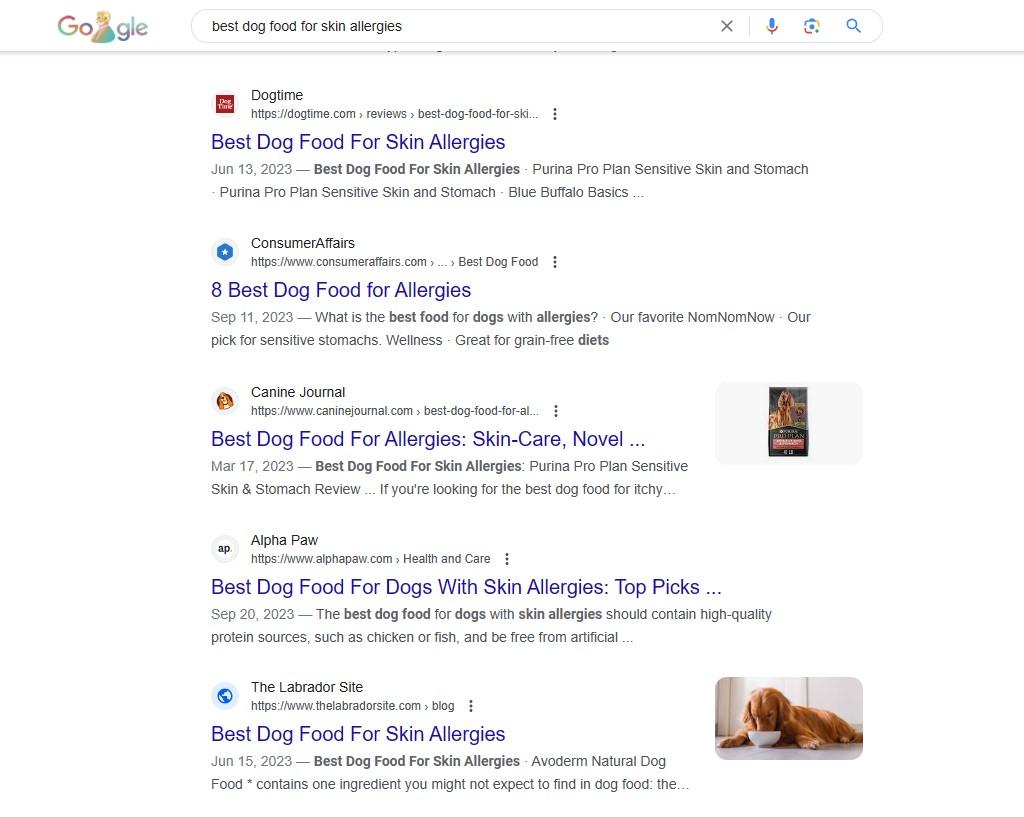
Focus on bloggers and informational sites. These websites are more receptive to collaborations and link insertions than brands.
High-quality content is key to a great link insertion.
Visit the site and spend some time looking at their content. Does the site provide helpful and accurate information?
You can also analyze your competitors links to find opportunities for link insertions. Check out our backlink analysis guide to find out how.
Use Ahrefs or Semrush for In-Depth Research
Once you’ve identified a potential target site, use an SEO tool to see if it’s worth reaching out.
When I look for the potential value of a link, I analyze these main SEO criteria:
– Referring Domains
– Metrics vs RD
– Site Age (Page Age In Terms of Link Insertions)
– Overall Link Profile Quality
– Quality of Content
– Site Traffic (+ Keywords)
– AnchorsWhat do you look for?
— Charles Floate 📈 (@Charles_SEO) October 9, 2022
Check the organic traffic and keyword rankings.
A site with more traffic and relevant keyword coverage will offer more visibility and SEO benefits.
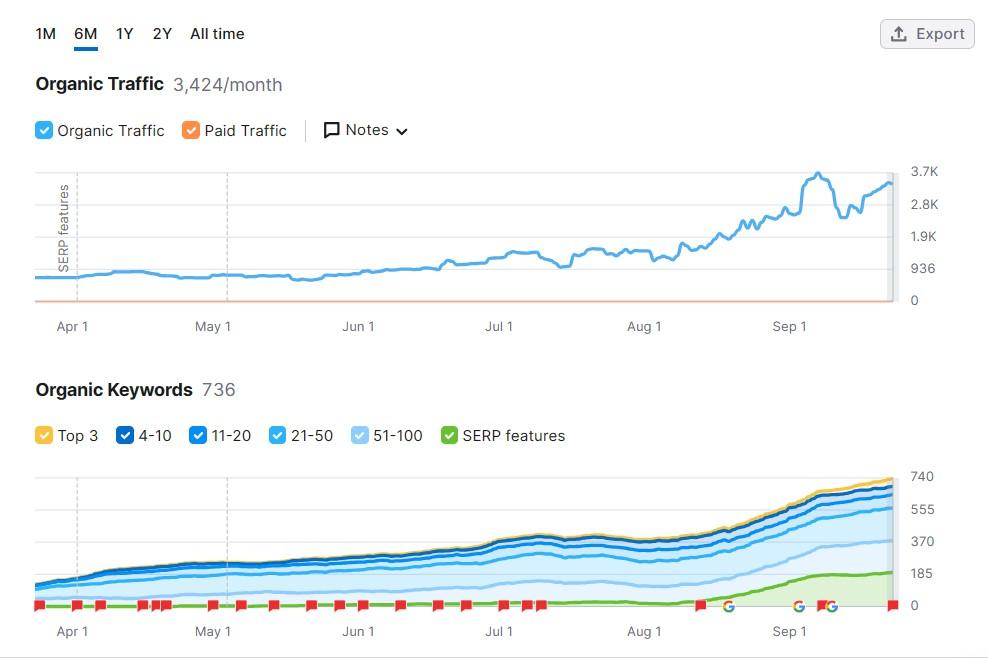
You should also check the target site’s backlink profile. Look at the overall DA and the specific referring domains.

A high DA site with lots of high-quality links will pass more authority to your site.
Identify Content for Your Link Insertion
The next step is identifying the page you want to add your link to.
There are two key things here: relevance and authority.
Relevance
You want to place your link in content relevant to the page you’re linking to.
For example, if your page is about coffee beans, you could target a page about the health benefits of coffee, brewing methods, or coffee equipment reviews.
The goal is to find a page where your link adds value and is a natural fit.
The fastest way to do this is to use Google search operators. In the search box, enter site:example.com with a relevant keyword.
This will show you all the indexed pages on the website related to the keyword:
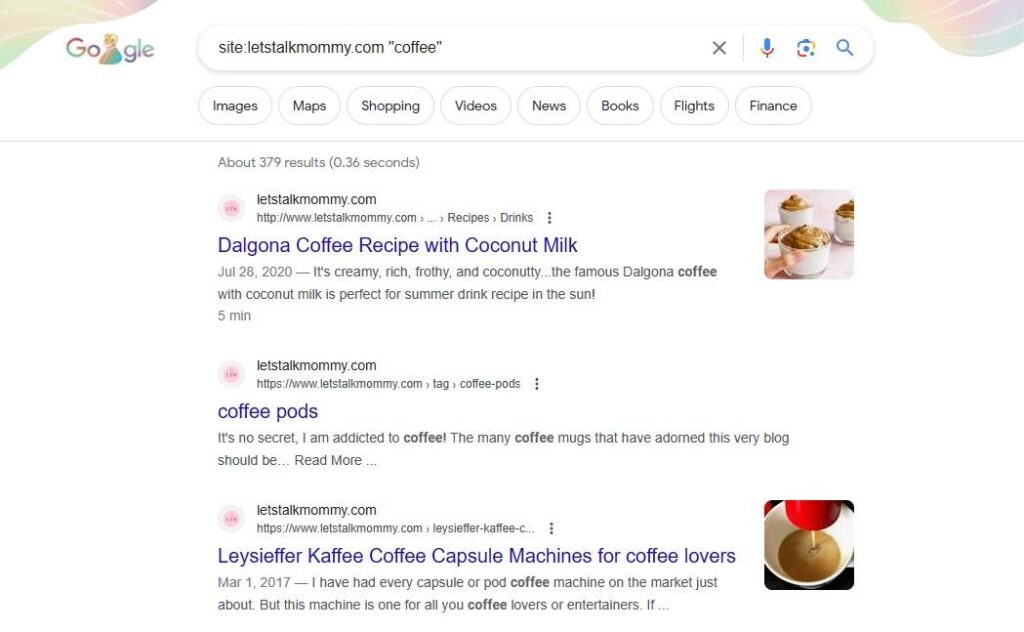
Authority
Inspect the website’s indexed pages to see which blog posts have the most links directed at them.
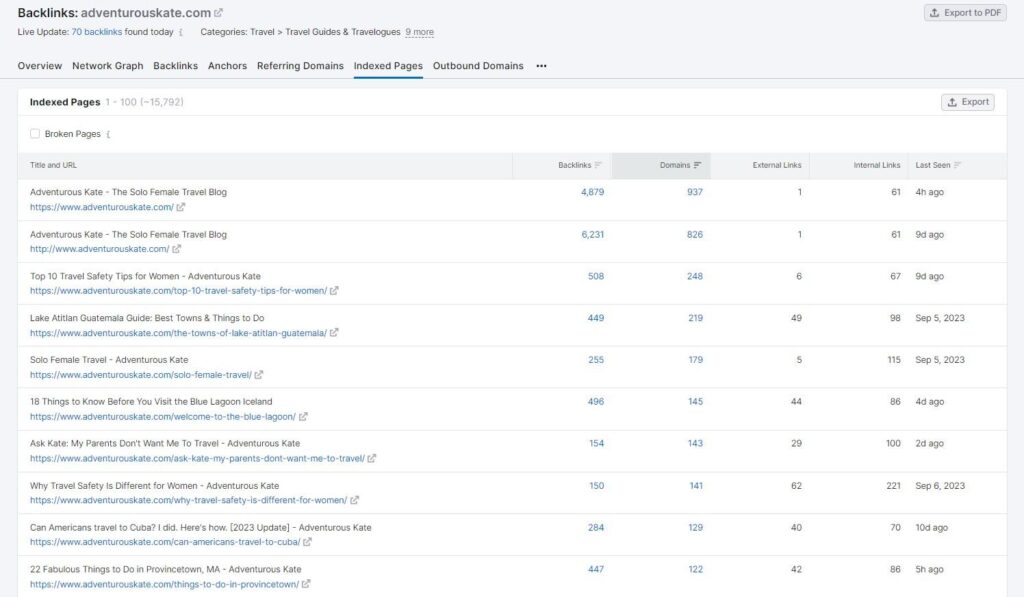
A link from one of these pages will offer the most SEO value.
You can check all of the indexed pages or narrow in on specific URLs.
It’s also important to look at the number of external links already on the page. A high number of external links can dilute the value of each link.
Outreach
With a target website and relevant page, you’re ready to reach out to the site owner.
You can usually find a contact form or email address on a “Contact Us” page.
Alternatively, you can use a tool like Hunter to find all publicly available email addresses associated with the domain.
It’s always worth doing some extra research to find the name of the person behind the website. That way, you can personalize your outreach.
In your outreach email, be clear and concise.
Briefly introduce yourself and explain why you’re reaching out.
Mention how it will benefit them. That could be enhancing their content with a link to a valuable resource or the monetary value of an editorial fee for adding the link.
Backlink Outreach Is Spammy
You can do backlink outreach right. Most don’t. But you can… You can:
– Be human
– Add a TL:DR
– Reach out with value
– Make it easy to help you
– Ensure it’s actually relevant
– Actually personalize the emailAnd get the links you want.
— Ross Simmonds (@TheCoolestCool) June 28, 2021
Negotiate Terms
If the site owner is open to a collaboration, the next step is to negotiate the specifics of the link itself.
You’ll want to discuss the anchor text used. Anchor text is the visible, clickable text of a link.
Ideally, it should be highly relevant to the keyword you’re targeting. But it should also be descriptive and naturally fit into the existing content.
It’s important to avoid using exact-match anchor text for multiple link insertions.
Don’t build backlinks with exact-match anchor text
Google will hit you with a spam penalty
Follow these rules:
– Don’t use the same anchor twice, unless it’s your brand name
– Anchor with synonyms of your keyword
– Use exact-match anchor sparingly (less than 10% of the time)
— Kai Cromwell | SEO (@KaiCromwell) May 8, 2023
You’ll also need to confirm your link placement will be a ‘follow’ link. These links have more impact on search ranking.
Monitor and Analyze Performance
Once you’ve placed a few links, you can measure the impact of the backlinks on your website.
First, you can check Google Analytics to see if your links are generating referral traffic.
Segment your referral traffic by session source to see how many people have clicked your link and visited your site.
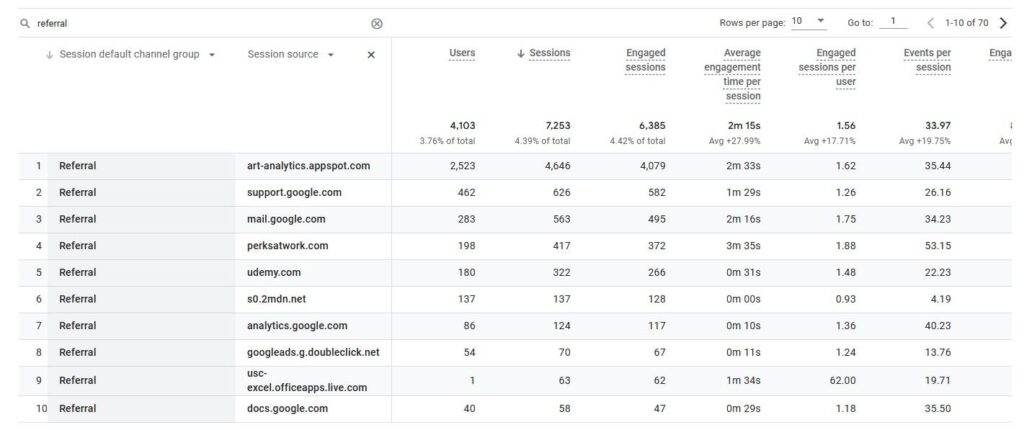
Beyond referral traffic, you also want to know the impact of your link building strategies on your search engine rankings.
While link insertions tend to have a faster impact than guest posting, it can still take time to see results.
In a recent survey, 46.6% of SEOs believed it takes 1-3 months for new links to have an impact on ranking:
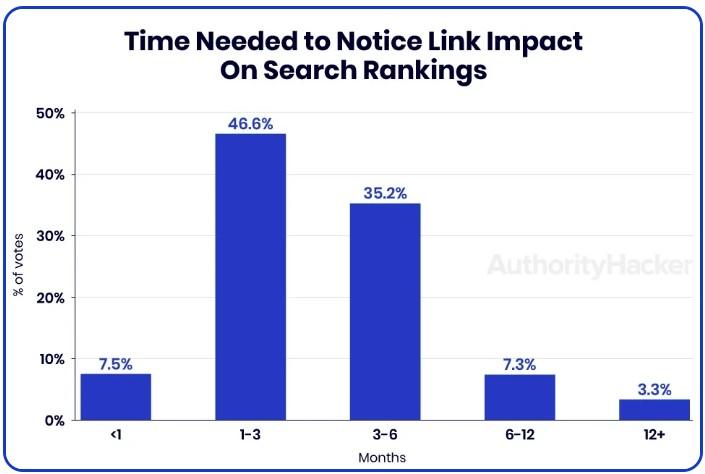
Keep an eye on your search ranking. If you start to see an increase in ranking for your target keywords, it could be a direct result of your link building efforts.
Outsource Link Insertions
Link insertions can be less demanding than guest posting. You don’t have to create fresh content for every link.
But it’s still not easy.
And if you’re managing link building campaigns for multiple clients, it’s a significant challenge.
That’s why many agencies choose to outsource their link building services. Instead of handling everything in-house, you can get external specialists like fatjoe to do it for you.
They can identify suitable websites, connect with site owners, and secure relevant link placements.
You can outsource the deliverables, focus on strategy, and expand your client base without overstretching.
It’s a lot easier to rank higher if you build quality backlinks. But if you’re good at the content side of SEO, you can outsource your link-building and focus on what you’re good at.
— Chris M. Walker (@cmwalker) February 27, 2022
Outsourcing allows you to scale operations up or down based on demand without overwhelming your in-house team.
Linking it All Together: Link Insertions and Agency Growth
Link insertions are a smart way to build links. It’s more scalable and can deliver faster results than other link building strategies.
But it takes time and know-how to do it right. And it should be part of a broader link building strategy to avoid any search engine penalties.
Focus on highly relevant, authoritative sites and look for opportunities where your link can add value to the existing page.
Become a Pro at SEO
Join 65,000 others and learn the secrets to SEO success with our weekly blog posts.
